It is always fascinating how some things might take a lifetime to connect the dots. Though I don’t take it too seriously, I’ve dabbled in collecting stamps (philately) for 55 years. It all started when I was 10 years old. As a child our morning cereal always consisted of oatmeal. Except on weekends when we were allowed box cereal. One cereal I chose was Muffets. They were like a shredded wheat, and didn’t have a lot of flavor. But I liked it most for the little toys or trinkets that were enclosed. Much like those Cracker Jack boxes. One year during the 1960’s the prize was stamps. Each Muffet box had a little envelope of around 15-20 colorful stamps from all over the world. I was hooked. My mom got me a beginners stamp album at Woolworths. I didn’t have a clue of what I was doing and pasted all those “prized” stamps in my album.
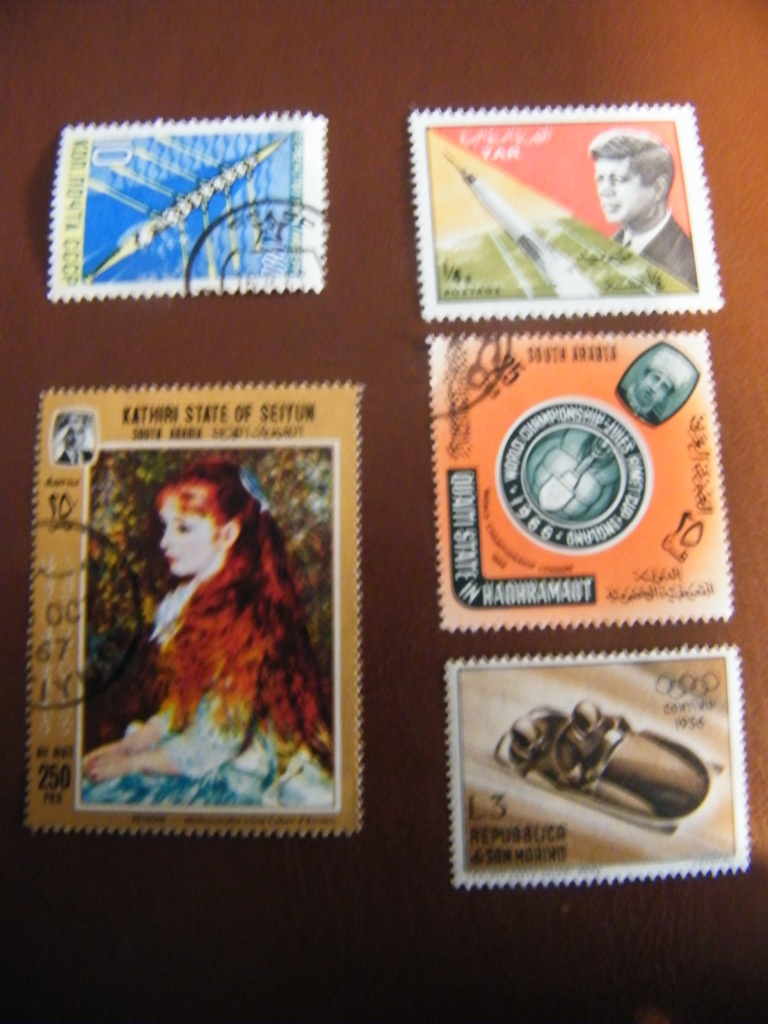
I soon learned you don’t glue stamps in an album and that there is not a chance a person could keep up with all the stamps in the world. And that some stamps are rare and very expensive. So I focused more on Canada of what my small budget could afford. A few years later I connected with a few other stamp collectors or philatelists by becoming a member of the Barrie and District Stamp Club. It was stamps that brought my wife and I together. At the Bible College I was attending a young lady received a letter from her mom and dad in New Zealand. I got really bold and asked to see the stamps on her letter. That’s how it all started. Over the years, with a marriage and 4 children in between my wife Lynne has passed every stamp envelope on to me since, over the past 37 years. So I can say I also collect New Zealand.

Canada has been issuing postage stamps since 1851. Before confederation it was called the Province of Canada. When Canada became a nation in 1867, they called it the Dominion of Canada. The provinces of British Columbia, New Brunswick, Nova Scotia, Prince Edward Island and Newfoundland all issued their own stamps (and had their own currency) before joining the Dominion of Canada. Contrary to those “wallpaper” issues, these stamps issued by the provinces are desirable for collectors. I only have a very small number of provincial stamps. Many of their issues are for those philatelists with deeper pockets than me. Most of the provincial stamps I have are from Newfoundland, which joined Canada later in 1949. My favorite issue from Newfoundland is the Trail of the Caribou, issued in 1919. I find the engraving is so beautiful. But I didn’t know a whole lot about the background of the issue. That is until today.
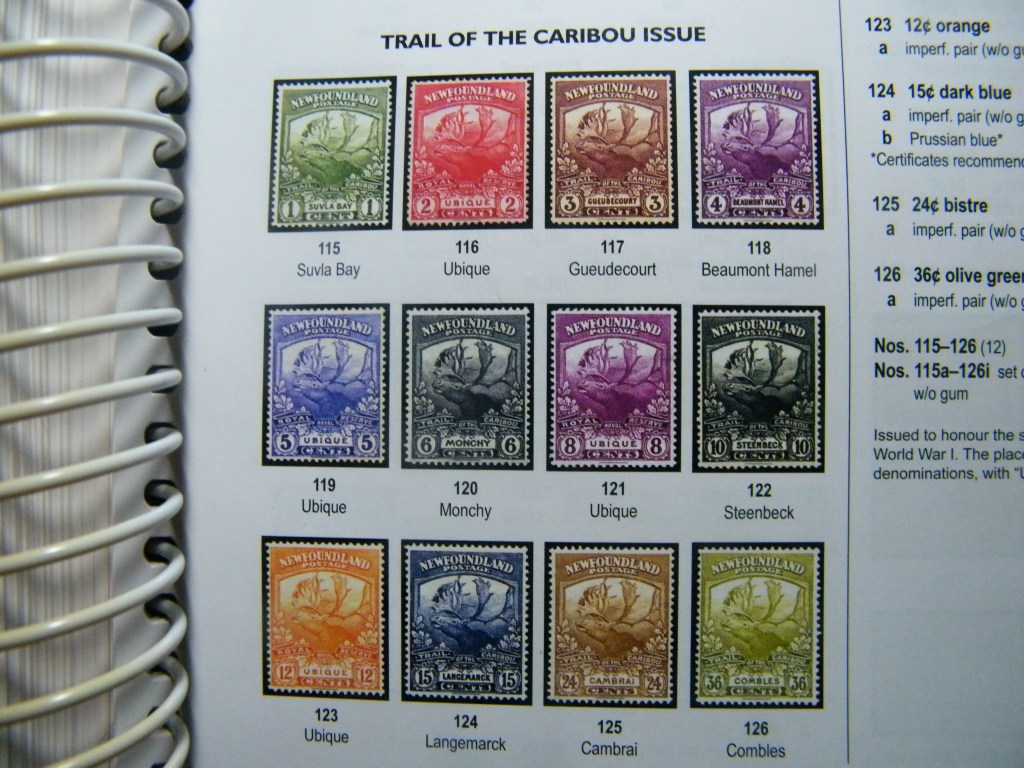
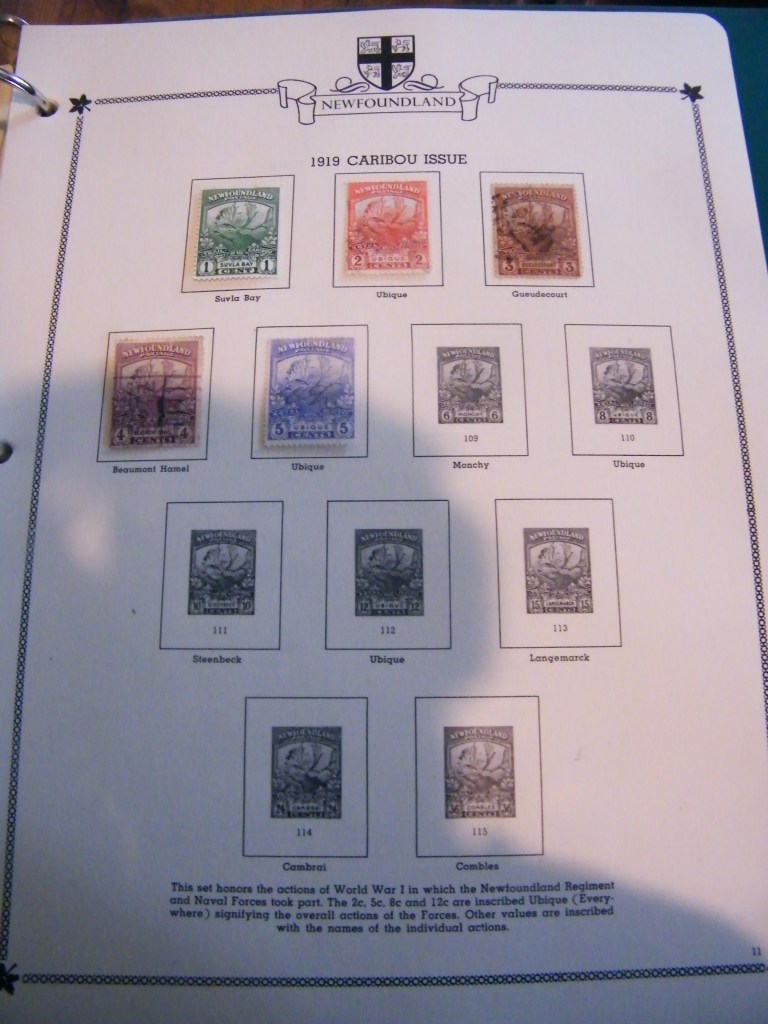
It’s been a really rough week. An event that took place has left me very sad and broken. On impulse this morning I did something I now regret. I deleted my bucket list page here on my blog. Before I decided to delete my entire blog, I flipped over to Twitter. But made certain I would not go on my Twitter feed, which could be hazardous mentally when I’m not in the right frame of mind. Instead I went on to the Twitter page of Stan Collins, a wonderful photographer who takes amazing photos of his home province of Newfoundland and Labrador. It worked. Stans photos were very calming and settled my mind.
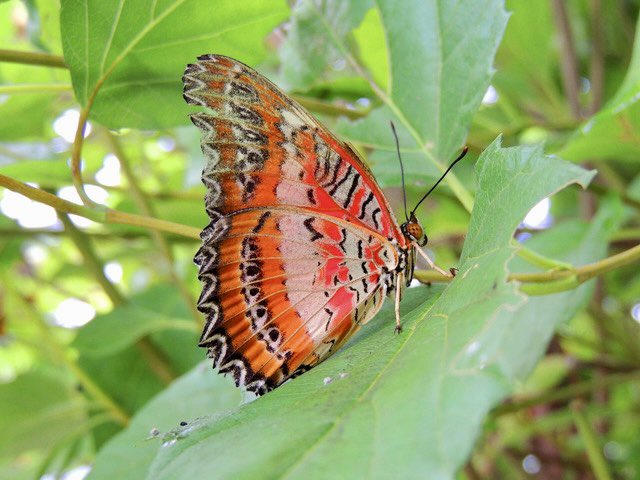
As I was scrolling down through all Stan’s beautiful photos today on July 1st, a different kind of tweet from Stan really caught my attention. It read as follows, “Please take a moment to remember that on this day in 1916 most of the Royal Newfoundland Regiment was wiped out in less than 30 minutes fighting evil forces in Canada’s defence. Of the 800 men who fought, only 68 answered roll call the next day. LEST WE FORGET.” I was stunned. How is it that I never heard of this before? All of a sudden the event that blindsided me this past week, didn’t seem quite as big.
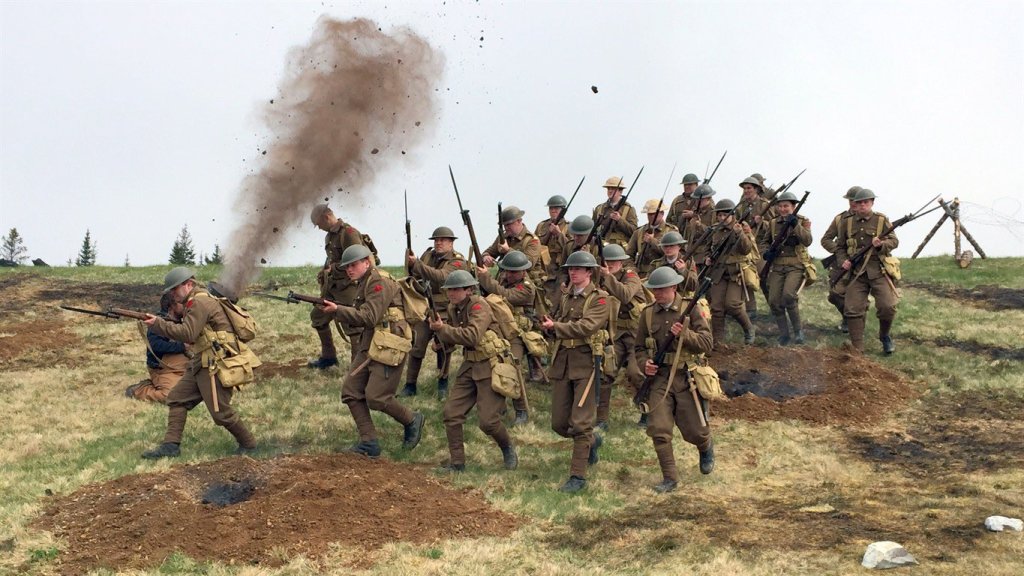
I switched on to research mode and through the Canadian Encyclopedia came across what I thought might be the event Stan was referring to. I got back to Stan and asked him, “Was it the first day of the Battle of the Somme?” He replied, “Yes it was, Carl.” Many historians regard this battle which lasted over four and a half months the bloodiest in human history. This battle, near the Somme River in France, symbolized the horrors of war in World War 1. On July 1st, day one of the battle of what Stan was referring to was described by the Canadian Encyclopedia, “It was near the north of the Somme Valley front near the village of Beaumont-Hamel about 800 troops of the First Newfoundland Regiment were gathered on 1 July in a support trench nicknamed St. John’s Road. At 9:15am the Newfoundlanders began their assault, crossing no man’s land in rehearsed lines.” I can’t even begin to imagine what must have been going through these young Newfoundlander soldiers minds as they pressed forward into what ended up being a German machine gun firestorm. This is something that cannot be lost in time. More than 700 soldiers of the First Newfoundland Regiment who went to war as part of the British Allied Forces were cut down in under 30 minutes at Beaumont-Hamel. Today, at this very battlefield at Beaumont-Hamel, France there is a park. On the highest part there is a statue of a caribou on top of a memorial which commemorates the Royal Newfoundland Regiment. It looks out over the field where so many died. This memorial is known as being a part of the Trail of the Caribou. As listed in this Government of Canada website, there are six of these battlefield memorials to commemorate Newfoundland’s accomplishments, contributions and sacrifices in Europe during the First World War. The caribou is an important symbol to the people of Newfoundland and Labrador. And the caribou is the emblem of the First Newfoundland Regiment.
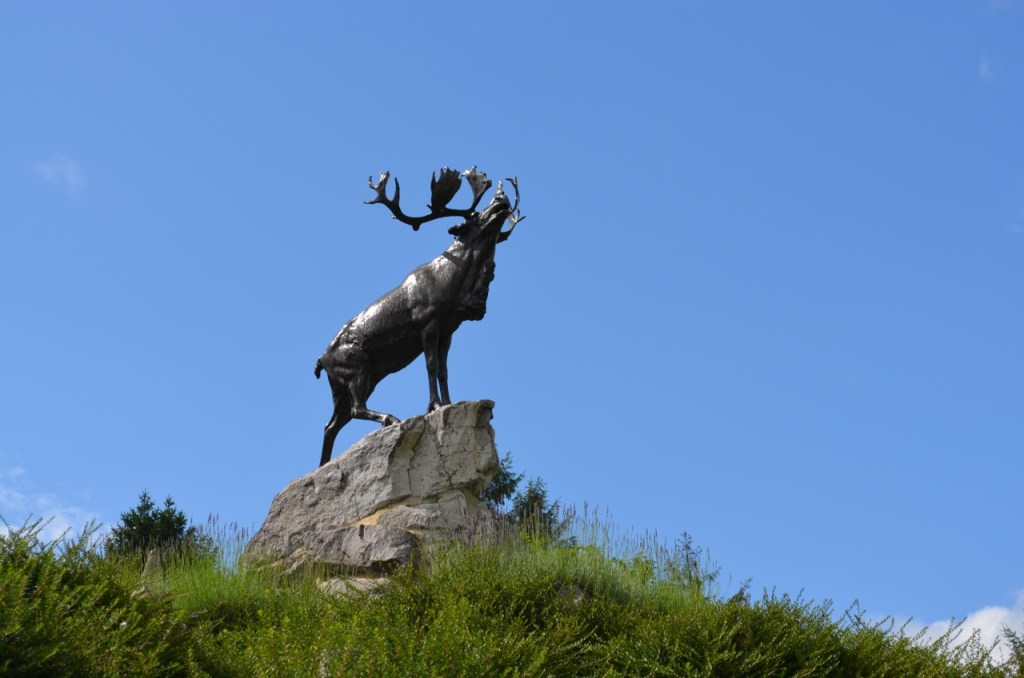
As I continued to connect my dots, I remembered my favorite Newfoundland stamp set issued in 1919 called Trail of the Caribou. I pulled out my stamp album. There are 12 issues in the set. I have the 5 lower value stamps. The website Stamp Collecting World gives important insight into this set of stamps. The stamps are divided into two different groups through their inscriptions. Four stamps in this set are inscribed “Royal Naval Reserve”, referring to the contributions of the Royal Newfoundland Naval Reserve forces during World War I. Each of these stamps is also inscribed with the Latin word “Ubique”, which means Everywhere. The second group of stamps are inscribed “Trail of the Caribou”. These stamps refer to the contributions of the Royal Newfoundland Regiment ground forces during World War 1. Each of these stamps are inscribed with the name of a military engagement in which Newfoundland troops took part. The four cent violet colored stamp is inscribed Beaumont Hamel. Representing a battlefield where more than 700 soldiers of the First Newfoundland Regiment were cut down on July 1st, 1916. Almost their entire regiment. The copy of my four cent Beaumont Hamel stamp is not that great of quality. It is not a valuable stamp to begin with. It is off centered and has a tear at the top. Some philatelists might even call it a reject. But for me, now knowing the background behind the issuance of this stamp, it is a stamp of great worth. It has been issued from the sacrifice of well over 700 young men who fought for our freedom. And paid the ultimate price.

Final Thoughts: We really have a great country here in Canada. Canada is worth celebrating. Our freedom is extremely important. As we gather to have our barbeques, go to the beach or watch fireworks, I learned that the people of Newfoundland and Labrador (on top of all that) observe Memorial Day. It is in honour of those incredibly brave men of the First Newfoundland Regiment who valiantly fought at Beaumont-Hamel. Thank you Stan Collins, my Twitter friend from Newfoundland and Labrador for sharing that tweet. LEST WE FORGET.



Thank you, Carl, for that somber history lesson. Lest we forget.
LikeLiked by 1 person
You are very welcome, Mary Lou. Thank you for taking the time to read. Yes, lest we forget.
LikeLike
Thanks for the history lesson. Such a tragedy. Ashamed that I didn’t know about this. Hope you are doing better also
LikeLiked by 1 person
You are welcome. Thank you for taking the time to read. So much sacrifice for freedom. I appreciate your kind words and concern. I’m still working through and trying to process everything. I’ll be okay. Thank you so much. 🙏
LikeLike
I didn’t know that you got to know each other through stamps! That’s a lovely story – and I LOVE your wedding photo! Such a beautiful couple!
So much to learn from this post, Carl. From the Caribou stamps to the Battle of the Somme with the Newfoundland Regiment. Thank you for all the research and sharing it with us!
War is such a terrible man-made tragedy! It’s even worse to think that we haven’t learned anything from the horrors of WW1. Up to this day, several bitter wars are going on with a death toll causing untold heartbreak on both sides.
I am sorry to hear that you had such a rough week. Who knows, maybe it was a good idea to delete the bucket list. This will give you the opportunity to write a new one! Our views change over time and it’s good to update those kinds of lists regularly.
Keep up the good work, Carl!
LikeLiked by 1 person
Thank you so much for taking the time to read and for your comment, Catrina. Wars really are such a tragedy. I can’t get my mind around that in some counties there has never been freedom. War has been the only thing they have known.
It has been an interesting couple of weeks, needless to say. Just like last year with the church closing, my training has pretty much gone off the rails with this latest. This link which takes you to a petition will full in the blanks of what has happened. The community is uniting and really ready to fight. Some really amazing comments from them.
https://www.change.org/p/save-our-crossing-guard?recruiter=1311960504&recruited_by_id=1278c9d0-1deb-11ee-9d37-0d6533848288&utm_source=share_petition&utm_campaign=share_for_starters_page&utm_medium=copylink&fbclid=IwAR27hQYayXz9FmJxxemkw9xSPdjKTmYSOPBi9zkzhzRxHunEmNhKJOnsBNY
LikeLiked by 1 person
Oh my goodness! Getting rid of the crossing guard is the worst decision ever!
I can’t believe it.
I’m so sorry this is happening to you, Carl.
Yes, it’s very similar to the church closing.
However, I am sure that the community’s protest will be effective in this case.
Children’s lives are at stake!
LikeLiked by 1 person